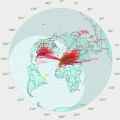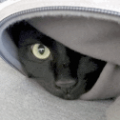benson
About
- Username
- benson
- Joined
- Visits
- 7,796
- Last Active
- Roles
- Member
- Points
- 12
-
sdr.hu is now REALLY closed for non-amateurs
An article in 'Janes Intelligence Review' last year certainly points in that direction. A snippet of that article can be found in the link below. Written by one of Jane's editors it might carry some weight.
link: https://www.janes.com/images/assets/042/83042/Software-defined_radios_point_way_for_simpler_direction_finding.pdf -
sdr.hu is now REALLY closed for non-amateurs
One of those less well known but excellent alternatives is directKiwi created by llinkz.
(https://github.com/llinkz/directKiwi)
The program allows you to select any of the available Kiwi receivers on a map interface GUI and get the streaming audio signal, with a mouse click you can obtain the current SNR estimate as used to be available on Marco's IS0KYB website using his micro -kiwi-waterfall routine and it shows the not so frequently updated SNR measurements from rxfanel page.
I have been using this for quite some time to find the better performing Kiwi's bypassing the obviously manipulated voting method that occurred at sdr.hu
73, Ben
-
Noise at roughly 60 KHz intervals
In the addition to all the good points above another thing that might be worth checking is the coax cables going to your receiver. I replaced one low quality cable with poor shield and center conductor connections and noticed almost 15 dB reduction in these 62 KHz EMI signals. Mind you this was a brand new Taiwan made cable, admittedly a low cost version.
Ben - SWLOI33 -
v1.246: GNSS Kalman filter, LED brightness control
Now that many more Kiwis are updated to V1.246 I do see quite a few more station that can be used for TDoA and some at good locations for multilateration.
Locally I noticed much improved position accuracies and about 95 pct of time all tracked GPS sattelites shown as "good" for position estimates.
So I am really impressed by the work and implementation of these extended Kalman filters by Christoph and John. Thank you both.
73, Ben - SWLOI33 -
GPS antenna trick
If your friend can have access to the roof of the building there might be better options. I had a similar situation in Taipei and managed to install an active antenna on the roof outside the view of the security cameras..hi.
Got some good results with an active whip design from the 1970's (Burhans) and a similar mini-whip design (PA0RDT) might work equally well. The building lightning protection ground worked o.k. as counterpoise.
Initially I used 40 m RG-174 coax and changed to LAN cable later which gave improved EMI suppression. For the latter some small baluns with FT-50J toroids were made. The unused cable pairs were used for 2 orthogonal active loops.
With the torrential monsoon rains in SIN waterproofing is really a necessity. In Taiwan the typhoons are an additional concern and eventually destroyed my high building rooftop installation blowing away most of it while water came running down the LAN cable even though sealed with self vulcanising tape...
73, Ben
PS: sri, quite a bit of thread drift from GPS reception -
KYOTO News FAX 16969.1 kHz 23:00utc
Over at Techzone ( https://goughlui.com/2019/01/13/radio-radiofax-hf-fax-reception-on-kiwisdr-with-kiwifax-py/ ) there is series of blog posts with a lot of current info about HF fax reception in general , active frequencies and slant corrections.
The author indeed shows that Kyodo as last HF fax news agency still transmits faxes at 60 lpm. Also he confirmed that BMF Taiwan has stopped its HF service long time ago and a good candidate for replacement in the Asia/Pacific drop down list would be XSG Shanghai.
He also made some mods to kiwifax.py in order to let it run continuously for DX station capture, suppress the log file and add some drift corrections for non GPS Kiwi nodes.
Regards, Ben -
Ionosondes
WA2ZKD wrote: seems like an extension for tracking one chirp TX could be possible (?)
I recently used some auxiliary programs to tune KiwiSDR (via Catsync) and tracking certain chirp sounders to see if propagation is open in parts of the HF spectrum. Even without using Chirpview these programs allow synchronising the Kiwi with the sounder visually by trial and error and although not giving precise propagation delays and signal strength still give a good impression which part of the spectrum is open towards a particular sounder. A short video recording is attached*.
Identifying those sounders remains a challenge like in the Chirpview days since the period & chirp time tables that can be found are all quite dated. I tried to use TDoA during stepper operation but usually only few usable points on the dt chart show up. The internet time delays probably wreak havoc not giving enough settling time for the remote Kiwis to be tuned to the stepped frequency. For the GPS locked sounders however the distance (path length) can be easily found using Chirpview.
Likewise using the audio chirps or beeps to create an ionogram from the sweeps would require a known time delay. For the TDoA project this was already determined. Generating ionograms might be possible on the Kiwi internally but internet connections show unpredictable and continuously changing delays. Using a PPS signal I measured 1.4 to 2.2 sec delays between Kiwi rx in and audio out using a PPS signal on a local network. As mentioned in the forum ionograms are already available from the large GIRO network showing the more modern DPS4D pulse sounders.
Three different programs were used that can step tune a receiver to follow chirp sounders. One (ref 1) tunes via a COM port output but is limited to 100 kHz/sec sweep rates and a 300 sec periods only.
The others I found (ref 2) are more flexible however tune either via a localhost or DDE interface via HRD (Ham Radio Deluxe). Still trying to figure out how to bypass HRD altogether and send the data directly to Catsync via a virtual COM port.
These steppers are not ideal and would need some modification in terms of interfacing, currently used sweep rates and sounder periods. Alternatively a frequency stepper could be built from scratch.
So who knows at some point if there is sufficient interest and after enough of the remaining chirp sounders are identified this could lead to a Kiwi extension where a particular sounder is identified via a drop down list.
ref 1 : https://www.qsl.net/pa1are/chirps.html
ref 2: http://www.m0dts.co.uk/?tag=HF
Best regards, Ben -
Browser session reset after 60 min
Thanks Powernumpty for your suggestions.
After connecting directly using an Ethernet cable between the Kiwi and a laptop the problem was still there.
Then upon closer inspection I noticed that in the additional html section of the admin web page I had entered a meta refresh instruction in order to limit refresh of data coming from an external website, which seemed to be a good idea at that time. So this problem - of my own making - is solved.
Ben -
sdr.hu is now REALLY closed for non-amateurs
One of those less well known but excellent alternatives is directKiwi created by llinkz.
(https://github.com/llinkz/directKiwi)
The program allows you to select any of the available Kiwi receivers on a map interface GUI and get the streaming audio signal, with a mouse click you can obtain the current SNR estimate as used to be available on Marco's IS0KYB website using his micro -kiwi-waterfall routine and it shows the not so frequently updated SNR measurements from rxfanel page.
I have been using this for quite some time to find the better performing Kiwi's bypassing the obviously manipulated voting method that occurred at sdr.hu
73, Ben
-
sdr.hu is now REALLY closed for non-amateurs
One of those less well known but excellent alternatives is directKiwi created by llinkz.
(https://github.com/llinkz/directKiwi)
The program allows you to select any of the available Kiwi receivers on a map interface GUI and get the streaming audio signal, with a mouse click you can obtain the current SNR estimate as used to be available on Marco's IS0KYB website using his micro -kiwi-waterfall routine and it shows the not so frequently updated SNR measurements from rxfanel page.
I have been using this for quite some time to find the better performing Kiwi's bypassing the obviously manipulated voting method that occurred at sdr.hu
73, Ben








